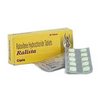 | Ralista (Aloxif) Ralista (raloxifene) is used for treatment and prevention osteoporosis in concerning by the period after a menopause of the woman. |
| Package | Per Pill | Price | Savings | Bonus | Order |
|---|---|---|---|---|---|
| 60mg × 30 pills | $2.43 | $72.96 | + Levitra | ||
| 60mg × 60 pills | $2.08 | $124.52 | $21.4 | + Viagra | |
| 60mg × 90 pills | $1.96 | $176.08 | $42.8 | + Cialis | |
| 60mg × 120 pills | $1.9 | $227.64 | $64.2 | + Levitra |
INDICATIONS
Ralista (Raloxifene hydrochloride) is a selective estrogen receptor modulator (SERM) that belongs to the benzothiophene class of compounds. Raloxifene's biological actions are largely mediated through binding to estrogen receptors. This binding results in activation of certain estrogenic pathways and blockade of others. Thus, raloxifene is a selective estrogen receptor modulator (SERM).
INSTRUCTIONS
The recommended dosage is one 60-mg Ralista tablet daily, which may be administered any time of day without regard to meals.
DOSAGE
Use the medicine as prescribed by your doctor.
If you miss a dose of Ralista, skip the missed dose and go back to the regular dosing schedule. Do not take 2 doses at once.
STORAGE
Store Ralista at 77 degrees F (25 degrees C), in a tightly closed container. Brief storage at temperatures between 59 and 86 degrees F (15 and 30 degrees C) is permitted. Store away from heat, moisture, and light. Do not store in the bathroom. Keep Ralista out of the reach of children and away from pets.
MORE INFO:
Active Ingredient: RaloxifeneRaloxifene decreases resorption of bone and reduces biochemical markers of bone turnover to the premenopausal range. These effects on bone are manifested as reductions in the serum and urine levels of bone turnover markers, decreases in bone resorption based on radiocalcium kinetics studies, increases in bone mineral density (BMD) and decreases in incidence of fractures. Raloxifene also has effects on lipid metabolism. Raloxifene decreases total and LDL cholesterol levels but does not increase triglyceride levels. It does not change total HDL cholesterol levels. Preclinical data demonstrate that raloxifene is an estrogen antagonist in uterine and breast tissues. Clinical trial data (through a median of 42 months) suggest that raloxifene lacks estrogen-like effects on the uterus and breast tissue.
Warnings/Precautions
Ralista is contraindicated in lactating women or women who are or may become pregnant. It may cause fetal harm when administered to a pregnant woman. Ralista is also contraindicated in women with active or past history of venous thromboembolic events, including deep vein thrombosis, pulmonary embolism, retinal vein thrombosis and in women known to be hypersensitive to raloxifene or other constituents of the tablets.
Venous Thromboembolism
In clinical trials, raloxifene treated women had an increased risk of venous thromboembolism (deep vein thrombosis and pulmonary embolism). Other venous thromboembolic events could also occur. A less serious event, superficial thrombophlebitis, also has been reported more frequently with raloxifene. The greatest risk for deep vein thrombosis and pulmonary embolism occurs during the first 4 months of treatment, and the magnitude of risk appears to be similar to the reported risk associated with use of hormone replacement therapy. Because immobilization increases the risk for venous thromboembolic events independent of therapy, Ralista should be discontinued at least 72 hours prior to and during prolonged immobilization (e.g., post-surgical recovery, prolonged bed rest), and Ralista therapy should be resumed only after the patient is fully ambulatory. In addition, women taking Ralista should be advised to move about periodically during prolonged travel. The risk-benefit balance should be considered in women at risk of thromboembolic disease for other reasons, such as congestive heart failure, superficial thrombophlebitis and active malignancy.
Endometrium
Ralista has not been associated with endometrial proliferation. Unexplained uterine bleeding should be investigated as clinically indicated.
Breast
Ralista has not been associated with breast enlargement, breast pain, or an increased risk of breast cancer. Any unexplained breast abnormality occurring during Ralista therapy should be investigated.
History of Breast Cancer
Ralista has not been adequately studied in women with a prior history of breast cancer.
Renal Insufficiency
Since negligible amounts of raloxifene and eliminated in urine, a study in patients with renal insufficiency was not conducted. In the osteoporosis treatment and prevention trials, raloxifene and metabolite concentrations in women with estimated creatinine clearance as low as 21 mL/min are similar to women with normal creatinine clearance.
Hepatic Dysfunction
Raloxifene was studied, as a single dose, in Child-Pugh Class A patients with cirrhosis and total serum bilirubin ranging from 0.6 to 2.0 mg/dL. Plasma raloxifene concentrations were approximately 2.5 times higher than in controls and correlated with bilirubin concentrations. Safety and efficacy have not been evaluated further in patients with hepatic insufficiency (see WARNINGS).
Pregnancy
Pregnancy Category X -- Ralista should not be used in women who are or may become pregnant.
Lactation
Ralista should not be used by lactating women . It is not known whether raloxifene is excreted in human milk.
Pediatric Use
Ralista should not be used in pediatric patients.
Use in elderly
In the osteoporosis treatment trial of 7705 postmenopausal women, 4621 women were considered geriatric (greater than 65 years old). Of these, 845 women were greater than 75 years old. Safety and efficacy in older and younger postmenopausal women in the osteoporosis treatment trial appeared to be comparable.
Use in Men
Safety and efficacy have not been evaluated in men.The safety of raloxifene in the treatment of osteoporosis was assessed in a large (7705 patients) multinational placebo-controlled trial. Common adverse events considered to be related to raloxifene therapy were hot flashes and leg cramps. The majority of adverse events occurring during the study were mild and generally did not require discontinuation of therapy. These adverse events included infection, migraine, nausea, myalgia, insomnia, rash, conjunctivitis, vaginitis.
More Information
Incidents of overdose in humans have not been reported. In an 8-week study of 63 postmenopausal women, a dose of raloxifene HCl 600 mg/day was safely tolerated. No mortality was seen after a single oral dose in rats or mice at 5000 mg/kg (810 times the human dose for rats and 405 times the human dose for mice based on surface area, mg/m 2) or in monkeys at 1000 mg/kg (80 times the AUC in humans). There is no specific antidote for raloxifene.
 PhexinPhexin (Cephalexin) is used for the treatment of bacterial infections of the respiratory tract such as middle ear, bones, pneumonia, reproductive, skin and urinary systems.as low as $3.45
PhexinPhexin (Cephalexin) is used for the treatment of bacterial infections of the respiratory tract such as middle ear, bones, pneumonia, reproductive, skin and urinary systems.as low as $3.45 AlbenzaAlbenza is used to treat infections caused by worms. Albendazole works by keeping the worm from absorbing sugar (glucose), so that the worm loses energy and dies. as low as $0.39
AlbenzaAlbenza is used to treat infections caused by worms. Albendazole works by keeping the worm from absorbing sugar (glucose), so that the worm loses energy and dies. as low as $0.39 OxytrolOxytrol is used for relieving symptoms of bladder problems (urinary urgency, frequency, or leakage; loss of bladder control; and painful urination) in certain patients.as low as $0.92
OxytrolOxytrol is used for relieving symptoms of bladder problems (urinary urgency, frequency, or leakage; loss of bladder control; and painful urination) in certain patients.as low as $0.92 ImdurImdur is used to prevent angina attacks (chest pain).as low as $1.05
ImdurImdur is used to prevent angina attacks (chest pain).as low as $1.05 SinemetSinemet (Carbidopa/Levodopa) is used for treating symptoms associated with Parkinson disease and parkinsonism-like symptoms.as low as $0.94
SinemetSinemet (Carbidopa/Levodopa) is used for treating symptoms associated with Parkinson disease and parkinsonism-like symptoms.as low as $0.94 DepakoteDepakote is used to treat various types of seizure disorders.as low as $0.83
DepakoteDepakote is used to treat various types of seizure disorders.as low as $0.83